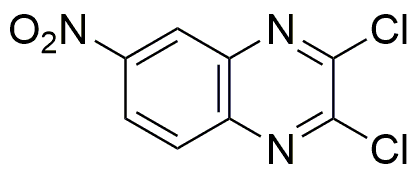2,3-Dichloro-6-nitroquinoxaline is widely utilized in research focused on:
- Neuroscience Research: This compound serves as a potent antagonist of certain glutamate receptors, making it valuable in studying excitatory neurotransmission and potential neuroprotective strategies.
- Pharmaceutical Development: It is used as a lead compound in the synthesis of new drugs targeting neurological disorders, providing insights into drug efficacy and safety profiles.
- Biochemical Assays: The chemical is employed in various assays to evaluate receptor activity and cellular responses, aiding researchers in understanding complex biochemical pathways.
- Material Science: Its unique properties allow for applications in developing specialized materials, such as sensors and electronic devices, where specific chemical interactions are crucial.
- Environmental Studies: The compound is also investigated for its effects on ecosystems, particularly in assessing the impact of pollutants on aquatic life, contributing to environmental protection efforts.
Información general
Propiedades
Seguridad y normativas
Aplicaciones
2,3-Dichloro-6-nitroquinoxaline is widely utilized in research focused on:
- Neuroscience Research: This compound serves as a potent antagonist of certain glutamate receptors, making it valuable in studying excitatory neurotransmission and potential neuroprotective strategies.
- Pharmaceutical Development: It is used as a lead compound in the synthesis of new drugs targeting neurological disorders, providing insights into drug efficacy and safety profiles.
- Biochemical Assays: The chemical is employed in various assays to evaluate receptor activity and cellular responses, aiding researchers in understanding complex biochemical pathways.
- Material Science: Its unique properties allow for applications in developing specialized materials, such as sensors and electronic devices, where specific chemical interactions are crucial.
- Environmental Studies: The compound is also investigated for its effects on ecosystems, particularly in assessing the impact of pollutants on aquatic life, contributing to environmental protection efforts.
Documentos
Hojas de datos de seguridad (HDS)
La SDS proporciona información de seguridad completa sobre la manipulación, el almacenamiento y la eliminación del producto.
Especificación del producto (PS)
La PS proporciona un desglose completo de las propiedades del producto, incluida la composición química, el estado físico, la pureza y los requisitos de almacenamiento. También detalla los rangos de calidad aceptables y las aplicaciones previstas del producto.
Certificados de análisis (COA)
Busque certificados de análisis (COA) ingresando el número de lote del producto. Los números de lote y de partida se pueden encontrar en la etiqueta de un producto después de las palabras "Lote" o "Lote".
Número de catálogo
Número de lote/lote
Certificados de origen (COO)
Este certificado de origen confirma el país en el que se fabricó el producto y también detalla los materiales y componentes utilizados en él y si se deriva de fuentes naturales, sintéticas u otras fuentes específicas. Este certificado puede ser necesario para cumplir con las normativas aduaneras, comerciales y regulatorias.
Número de catálogo
Número de lote/lote
Hojas de datos de seguridad (HDS)
La SDS proporciona información de seguridad completa sobre la manipulación, el almacenamiento y la eliminación del producto.
DownloadEspecificación del producto (PS)
La PS proporciona un desglose completo de las propiedades del producto, incluida la composición química, el estado físico, la pureza y los requisitos de almacenamiento. También detalla los rangos de calidad aceptables y las aplicaciones previstas del producto.
DownloadCertificados de análisis (COA)
Busque certificados de análisis (COA) ingresando el número de lote del producto. Los números de lote y de partida se pueden encontrar en la etiqueta de un producto después de las palabras "Lote" o "Lote".
Número de catálogo
Número de lote/lote
Certificados de origen (COO)
Este certificado de origen confirma el país en el que se fabricó el producto y también detalla los materiales y componentes utilizados en él y si se deriva de fuentes naturales, sintéticas u otras fuentes específicas. Este certificado puede ser necesario para cumplir con las normativas aduaneras, comerciales y regulatorias.

